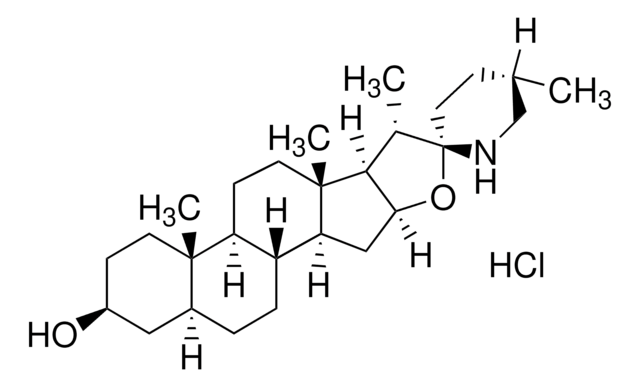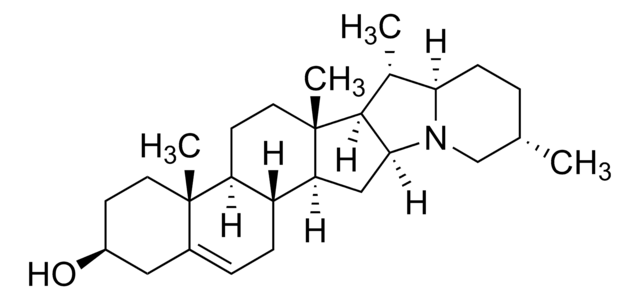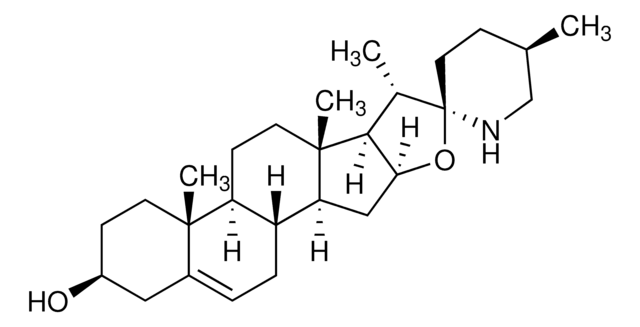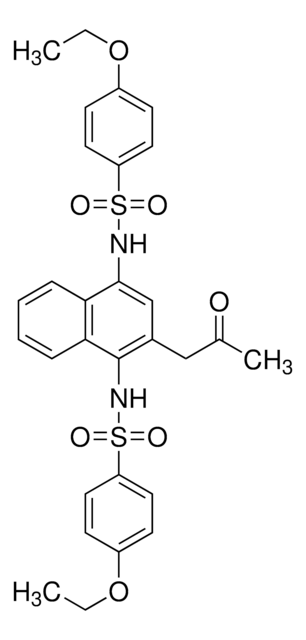T2909
Tomatidine hydrochloride
≥85%
Sinonimo/i:
3β-Hydroxy-5α-tomatidane hydrochloride, 5α-Tomatidan-3β-ol hydrochloride
About This Item
Prodotti consigliati
Saggio
≥85%
Temperatura di conservazione
2-8°C
Stringa SMILE
Cl[H].[H][C@@]12CC[C@]3([H])[C@]([H])(CC[C@@]4(C)[C@@]3([H])C[C@]5([H])O[C@]6(CC[C@H](C)CN6)[C@@H](C)[C@]45[H])[C@@]1(C)CC[C@H](O)C2
InChI
1S/C27H45NO2.ClH/c1-16-7-12-27(28-15-16)17(2)24-23(30-27)14-22-20-6-5-18-13-19(29)8-10-25(18,3)21(20)9-11-26(22,24)4;/h16-24,28-29H,5-15H2,1-4H3;1H/t16-,17-,18-,19-,20+,21-,22-,23-,24-,25-,26-,27+;/m0./s1
SXXHVPYRDFJKPG-XRWUXUKGSA-N
Cerchi prodotti simili? Visita Guida al confronto tra prodotti
Descrizione generale
Applicazioni
- to evaluate its effect on nasopharyngeal carcinoma using cell proliferation and flow cytometry assay
- as a negative control in the non-specific inhibition on hedgehog signaling in hepatocellular carcinoma cell lines
- as a control for cell growth assay and expression studies in pancreatic cancer cells
Azioni biochim/fisiol
Avvertenze
Warning
Indicazioni di pericolo
Consigli di prudenza
Classi di pericolo
Acute Tox. 4 Oral
Codice della classe di stoccaggio
11 - Combustible Solids
Classe di pericolosità dell'acqua (WGK)
WGK 3
Punto d’infiammabilità (°F)
Not applicable
Punto d’infiammabilità (°C)
Not applicable
Dispositivi di protezione individuale
Eyeshields, Gloves, type N95 (US)
Certificati d'analisi (COA)
Cerca il Certificati d'analisi (COA) digitando il numero di lotto/batch corrispondente. I numeri di lotto o di batch sono stampati sull'etichetta dei prodotti dopo la parola ‘Lotto’ o ‘Batch’.
Possiedi già questo prodotto?
I documenti relativi ai prodotti acquistati recentemente sono disponibili nell’Archivio dei documenti.
I clienti hanno visto anche
Il team dei nostri ricercatori vanta grande esperienza in tutte le aree della ricerca quali Life Science, scienza dei materiali, sintesi chimica, cromatografia, discipline analitiche, ecc..
Contatta l'Assistenza Tecnica.














